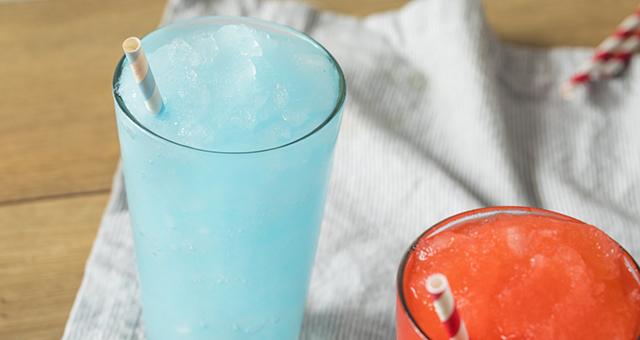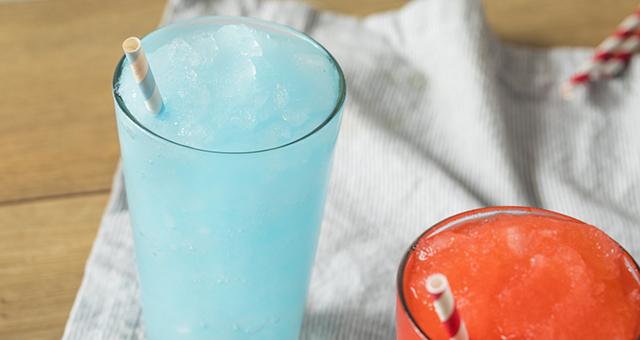
In How to Make Ice Cream in a Bag follow step-by-step directions at home for making your own ice cream. Find out the science behind how this works. Smart as well as delicious! Watch a demonstration of how this works in the video below. With a few simple ingredients you can be eating a DIY slushie cold treat in no time! Even on a very hot day!
A little bit simpler science recipe you can try is making a DIY slushie from your favorite drink. The same science principles apply! Your favorite drink is pretty good with ice floating in it. When your drink has ice cubes in it, the ice cubes make the drink colder, but the ice cubes don’t make the drink itself freeze. The ice cubes IN the drink melt because they are colder then the drink itself. The drink melts the ice cubes by lowering their temperature. If you want a slushie you need to put ice AROUND your drink instead of IN it.
Melting point is the temperature at which a solid will melt. For ice this temperature is 32 degrees. If you put a drink in the freezer, where the temperature is 32 degrees or colder, the drink itself will freeze. Solid. You won’t be able to drink it!
To make your DIY slushie you want the temperature around your favorite drink to be lower than 32 degrees so the drink itself will get really cold. Keep an eye on it and stir it a lot so it doesn’t freeze solid. Make an easy slushie using ice cubes and salt. Note: the salt does NOT go IN your drink!
Salt lowers the melting point of water. Adding salt to ice cubes makes them stay frozen longer. If ice with salt added to it is packed around a liquid, like your drink, the salted ice will make your drink so cold that it will turn into a slushie!\
What You Need:
- Your Favorite Drink (Soda, orange juice, lemonade, etc.)
- Quart-size zip-lock bag
- Gallon-size zip-lock bag
- 2 cups ice
- 1/4 cup salt
- Bowl
Fill the quart size bag with your favorite drink and zip it closed. HINT: Make sure the bag is zipped really good or your slushie will taste bad when some of the salt leaks into your bag. Put the quart size bag inside the gallon bag. Add the ice and salt to the gallon bag. Next, zip the gallon size bag closed. Finally, shake the bag a lot – even play catch with it…gently. In about 15 minutes you will feel the ingredients in the quart size bag starting to firm up. What started out as a liquid is changing to a solid. When it feels done take the quart size bag out of the gallon size bag. Rinse it off good in clean water. Then open the bag, squeeze the slushie into a glass and enjoy!
When you add salt to the ice cubes you lower the melting point of the ice cubes by several degrees. The ice cubes stay colder, longer – long enough to turn your drink slushie. The secret is the catalyst – the salt. A catalyst is a substance that increases the rate of a reaction.
Science Experiment Idea
Make 3 different quart size bags each filled with the exact same amount of your favorite drink. Fill each of three gallon size bag with the exact same number of ice cubes. Add 1/8 cup of salt to the first gallon size bag and label it with a sharpie, “1/8”. Then add 1/4 cup of salt to the second gallon size bag and label it “1/4”. Finally, add 1/3 cup of salt to the third gallon size bag and label it “1/3”. Have a couple friends help you shake and smoosh the bags to make the slushies. Time how long it takes each of the bags to turn into a slushie. Which amount of salt makes a DIY slushie the fastest?
Websites, Activities & Printables:
- PBS Kids: Fetch Ice Cream Shake
- Chem4Kids: Changing States of Matter
- Lunar and Planetary Institute: Melting Point
- High Touch High Tech Slushie Science
- Steve Spangler Science: Instant Freeze Water
- National Geographic Kids: Make Ice Cream

You can also ask a math and science expert for homework help by calling the Ask Rose Homework Hotline. They provide FREE math and science homework help to Indiana students in grades 6-12.
e-Books & Audiobooks
Use your indyPL Library Card to check out kitchen science books at any of our locations, or check out kitchen science e-books and audiobooks from OverDrive Kids right to your device! If you have never used OverDrive before, you can learn how to use it for both e-books and audiobooks.
Need more help? Ask a Library staff member at any of our locations or call, text or email Ask-a-Librarian. The Tinker Station helpline at (317) 275-4500 is also available. It is staffed by device experts who can answer questions about how to read, watch and listen on a PC, tablet or phone.
Ice Cream and Other Edible Science for Kids
Let your kitchen become a science lab and bake, melt, freeze, or boil an experiment you can eat!
